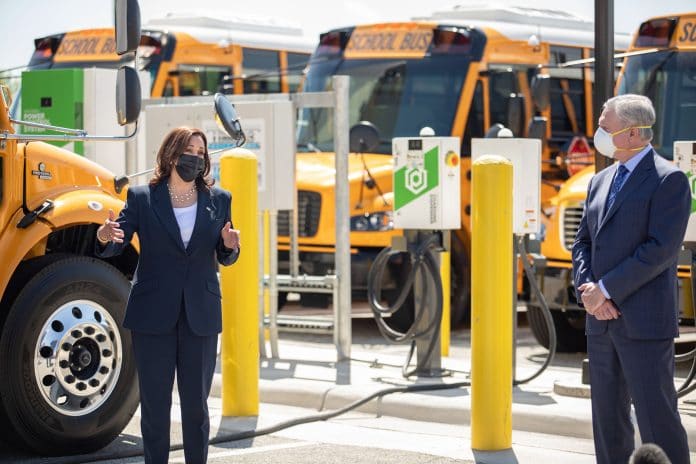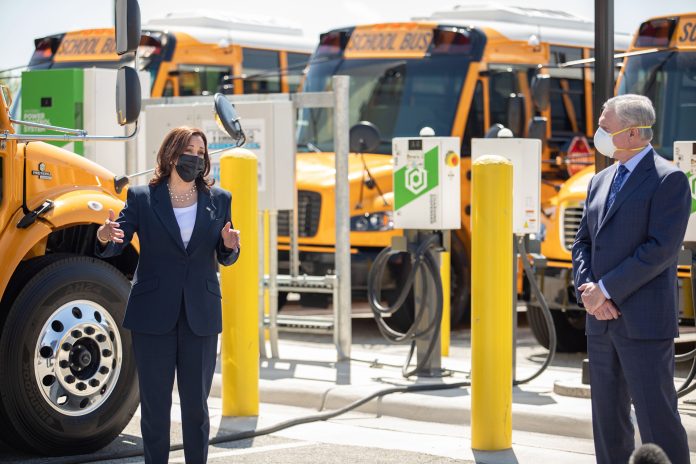Electric school buses are sustainable, efficient and, well, somewhat expensive. To help ease the financial burden of going electric, the government is opening phase one of the Clean School Bus Program, the Rebate Program.
It’s an exciting time to be in the school bus industry. In the era of EV adoption, the possibilities are endless for fleets looking to drive the future. However, given that electric school buses cost 3–4x the amount of regular diesel buses, budgeting for them can also feel overwhelming at times. Especially when looking for funding options.
Across the United States and Canada, several funding incentives are now available for districts adding electric buses to their fleets. One of the most exciting opportunities for U.S. districts is the Clean School Bus Program. As part of the Bipartisan Infrastructure Bill, this Environmental Protection Agency (EPA) program will provide $5 billion over the next five years for the replacement of diesel buses with zero- and low-emission school buses.
Why Electric Buses?
We’ve all heard about the earth-saving benefits of electric vehicles. What we don’t hear about as often, however, is the effect that some older (pre-2010) diesel buses may have on our wellbeing. While newer school bus models meet the EPA’s stringent emission standards, many older models emit pollutants that can be harmful to our health. For example, students are more susceptible to asthma and other respiratory illnesses caused by air pollution inside and near older buses.
Electric school buses like the Thomas Built Buses Saf-T-Liner® C2 Jouley® are emissions-free, noise pollution-free and fossil fuel-free, keeping kids healthier and helping you save on operating costs – while also saving the planet.
The Rebate Program
The first portion of the EPA Clean School Bus Program will provide funding via rebates that are specifically for school bus replacement and infrastructure costs. According to the EPA, this option provides the quickest route to getting fleets the dollars they need.
The Rebate Program will provide $500 million to fleets, half for zero-emission school buses and the other half for clean and zero-emission school buses. Buses eligible for replacement must be a 2010 or older diesel-powered school bus that will be scrapped if funding is awarded. For a full list of requirements, please visit the EPA website.
Fleets will be awarded funding through a lottery system, so all who submit applications on time will be eligible for infrastructure and electric or clean school bus funds. The EPA will also provide a chart that specifies the maximum amount of funds per bus that applicants are eligible to receive.
Per the Infrastructure Bill, the Rebate Program allows the EPA to prioritize school bus replacements in high-need school districts, tribal schools, rural and low-income areas or traditionally underserved communities. A higher cost-share may be awarded to these districts. The EPA plans to post a full list of prioritized applicants on its website.
Application Process and Timing
The application period for the Rebate Program begins in May and will last for three months, ending in August, giving districts ample time to submit their paperwork. The EPA has stated that applications will be submitted via an online form. To apply, your organization MUST HAVE an active System of Award Management (SAM.gov) entity registration and have points of contact listed under the organization. For help with this visit the Federal Service Desk, FSD.gov. The EPA will review all applications and make selections within 60 days after the end of the application process.
Thomas Built Can Help
Even with billions of electric bus funding dollars available in the U.S., the electric school bus funding application process can still feel daunting at times. As the Electric Bus Authority, Thomas Built has tools and resources to make your life easier when applying for opportunities like the Clean School Bus Program.
When it comes to infrastructure, working with a utility provider to bring power to your site and install EV bus equipment can take months. The EPA advises districts to reach out to utility partners now and begin the conversation. The Thomas Built team of EV specialist can help you with this as well as talk you through other infrastructure considerations.
Taking your fleet electric can feel overwhelming at times. Reach out to the Electric Bus Authority for help navigating the complex EV ecosystem.


